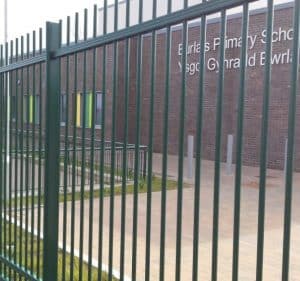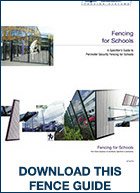Ten tips for specifying school perimeter fencing
24th January 2018

1- Security
Perimeter fencing deters casual trespassers and determined intruders. In addition, fencing helps to combat truancy and provides ‘peace of mind’ for parents. The circumstances are different for every school, which is why a risk assessment is so important (see later).
2- Aesthetics
Schools must appear welcoming, not threatening. Welded wire mesh, vertical bar (railing) and palisade fencing all have different visual characteristics as well as providing their own levels of security. Fencing and support posts can be supplied in a wide variety of colours.
3- Cost
When specifying perimeter fencing around a school, it has to be borne in mind that the most secure and most aesthetically attractive options are unlikely to be the cheapest. A balance, therefore, has to be struck between security, aesthetics and cost, while taking into account the results of the risk assessment.
4- Access points
Gates should be sited where they are clearly visible. Most suppliers of fencing offer gates for pedestrians and vehicles, as well as a choice of access control systems.
5- Additional security measures
Depending on the results of the risk assessment, it may be appropriate to bolster perimeter security with access control systems, CCTV, buried fencing or fence extensions.
6- Risk assessment
Before specifying or purchasing perimeter fencing a thorough risk assessment should be undertaken to understand the risks. Note that the risk assessment should be reviewed periodically or in the event of relevant changes to circumstances relating to the school or its environment. For medium- or high-risk schools, it is advisable to seek the services of perimeter security specialists.
7- Installation
A fence must be installed properly if it is to perform as intended. Installing fencing is a skilled job and specifiers should be aware that some fencing contractors hire unskilled labour on a project-by-project basis, rather than retaining a team of properly trained installers.
8- Maintenance
Good quality fencing should need minimal maintenance. However, occasional inspections should be carried out to ensure that trees have not grown to provide an easy means of climbing over the fence, bushes and other vegetation are not blocking the view from CCTV cameras (if installed), and that nothing else is compromising the security. Gate hinges and locks benefit from periodic maintenance.
9- Standards
Fencing materials are covered by numerous British, European and International standards. Specifiers need to be aware of these to ensure that suppliers are offering products that meet the appropriate standards.
10- A free guide to perimeter security fencing for schools
Procter Fencing Systems is the UK’s leading specialist manufacturer and installer of fencing and gates for schools. From its sites in Leeds, South Wales and Brentwood, Procter Fencing Systems offers a comprehensive service to survey, design, manufacture and install fencing and gates nationwide. All products meet the appropriate health, safety and product standards, and installation is carried out by the company’s own skilled installers. ‘Fencing for Schools – A Specifier’s Guide to Perimeter Security Fencing for Schools’ is available as a PDF file free of charge on request or it can be downloaded from the Free Downloads.

